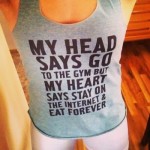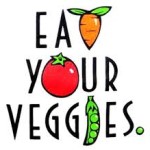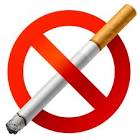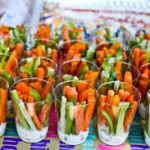healthy
now browsing by tag
The Psychology Of Losing Weight

An Alternative To Willpower For Losing Weight
Blogger: Terry Ryan (admin@slimhealthysexy.com)
A common belief, even among doctors, is that almost no one succeeds in losing weight in the long term. And for almost two decades, I’ve counted myself among the skeptics, being able to tally on the fingers of one hand the number of my patients who’ve managed to do it—literally less than five out of multiple hundreds, if not a few thousand.When I stumbled across the ideas put forth in the slow-carb diet though (“slow” in contrast to “low” because one cheat day a week is allowed), I became excited—and not just for my patients. Though I’ve never had much of a weight problem myself, after nine years of marriage, four years of fatherhood, and a consequent 50% reduction in the time I have available for exercise, I found I’d put on nearly twenty extra pounds. So when my wife noticed me noticing several inches of my abdomen hanging over the sides of my belt one day, she suggested I try the slow-carb diet myself. I did and shed the extra weight in just two months.
Because I found the diet both easy and effective, and because a number of studies have suggested that an excess of carbohydrate is likely a major contributor to the epidemic of obesity in North America, I began recommending the slow-carb diet to a number of my patients. And they started losing weight.
But not all of them. Some just couldn’t wrap their minds around the idea of giving up carbohydrates (including a cardiologist!) and didn’t even want to try it. Some tried it, but didn’t like it. And some liked it, but couldn’t stay on it.
This last group was the one that frustrated me the most. Here was an approach to weight loss that didn’t require calorie counting, knowledge of food groups, or portion control. They only needed to follow one simple rule to make it work: don’t eat carbohydrates six out of every seven days. Not to mention that almost all of them told me they didn’t actually miss the carbohydrates! So why did they fail?
“Weak willpower,” they said.
When I heard that, though, I became excited all over again, because the reason they gave me for their failure was wrong. A lack of willpower wasn’t what did them in. What did them in was their decision to use willpower in the first place.
THE PROBLEM WITH WILLPOWER
Willpower is not only among the weakest of mental forces, but in most people it actually fatigues with continued use. Some have suggested this is part of the reason the cheat day helps people stay on the diet: it gives their weary wills a much-needed chance to recover enough to resist the subsequent week’s temptations. The problem, though, is that the time horizon over which willpower fails isn’t days—it’s hours (not that the cheat day isn’t crucial—just not, in my view, for recharging the will).
This almost certainly explains why most of my patients who gave up the diet told me that when they would come across a tempting carb during the week, too often their wills weren’t strong enough to resist it. When they found themselves confronted with a piece of pie, a brownie, or a bagel—especially if it was near the end of the day—they’d end up eating it almost as often as they’d pass it by. It didn’t take too many weeks of failing this way for them to become discouraged and give up.
But the reason they failed wasn’t because the slow-carb diet doesn’t work. The reason they failed was because they were relying the wrong strategy to implement it. The key to resisting the temptation isn’t willpower. It’sdistraction, avoidance, and acceptance. What follows below, then, is the 7-point plan I gave them for beating temptation without relying on willpower.
THE 7-POINT PLAN
1. Distraction is more effective than willpower. In 1970 psychologist Walter Mischel famously placed a cookie in front of a group of children and gave them a choice: they could eat the cookie immediately, or they could wait until he returned from a brief errand and then be rewarded with a second. If they didn’t wait, however, they’d be allowed to eat only the first one. Not surprisingly, once he left the room, many children ate the cookie almost immediately. A few, though, resisted eating the first cookie long enough to receive the second. Mischel termed these children high-delay children.
How did they succeed? “Instead of focusing prolonged attention on the object for which they were waiting,” Mischel writes, “they avoided looking at it. Some covered their eyes with their hands, rested their heads on their arms, and found other similar techniques for averting their eyes from the reward objects.” In other words, Mischel concluded, distraction is superior to willpower for delaying gratification.
To resist a tempting pleasure, then, you have to find a way not to resist it but to distract yourself from it. How? With the most distracting thing there is: another pleasure.
2. The most effective way to distract yourself from one pleasure is with another pleasure. In a second study, Mischel placed two marshmallows side by side in front of a different group of children to whom he explained, as in the previous study, that eating the first before he returned to the room would mean they couldn’t eat the second. He then instructed one group of them to imagine when he stepped out of the room how much marshmallows are like clouds: round, white, and puffy. (He instructed a control group, in contrast, to imagine how sweet and chewy and soft they were.) A third group he instructed to visualize the crunchiness and saltiness of pretzels. Perhaps not surprisingly, the children who visualized the qualities of the marshmallows that were unrelated to eating them (that is, the way in which they were similar to clouds) waited almost three times longer than children who were instructed to visualize how delicious the marshmallows would taste.
Most intriguing, however, was that picturing the pleasure of eating pretzels produced the longest delay in gratification of all. Apparently, imagining the pleasure they’d feel from indulging in an unavailable temptation distracted the children even more than cognitively restructuring the way they thought about the temptation before them.
So when you want to avoid something tempting, read an engrossing book instead. Or watch a movie. Or listen to music. Something you find genuinely pleasurable. Or if for some reason you can’t engage in an alternative pleasure—or shouldn’t for some reason—think about doing it instead. For example, when you see a pizza, think about eating ice cream. As vividly as possible, imagine the specific sensations your tongue will experience as your favorite flavor of ice cream drips languorously down your throat and into your stomach. (On the other hand, thinking about one food when you’re trying to avoid eating another food may be too viscerally activating. Some people may need to turn their thoughts to a different kind of pleasure than the one they’re trying to avoid to make this strategy work for them.)
Or, alternatively, turn your focus to a problem you’re trying to solve. Whether a math problem, a brain teaser, a relationship issue, or a philosophical question, problem-solving is intrinsically engaging, and engagement is the key to distraction.
But not just any kind of engagement, it turns out. Emotionally arousing engagement. Turning to something you find merely intellectually interesting is often not enough, especially when you’re viscerally activated by hunger (or sexual attraction, or nicotine cravings, or whatever). You need to find something to distract you that makes you feel good. It could be thinking about an upcoming date or vacation, or an expected pay raise and all the things you’re going to buy with it, or that really awesome movie you’re going to be seeing later that day. But whatever it is…
3. Plan out your distraction ahead of time. Studies show that making decisions–even simple ones–also depletes willpower. If you’re constantly deciding what alternative pleasures to think about or pursue each time you face a temptation, you become progressively less likely to be able to make the strategy of distraction work. Which is when rationalizations gain the power to convince you it’s okay to do what you’re trying so hard not to. The key is having your response ready. To make using it a rule instead of an on-the-spot decision. Something that doesn’t require conscious thought. That way, when you’re abruptly confronted with a display of cookies at the office Christmas party, you don’t have to fumble for an effective distraction. You already have it ready to pull up automatically, without even thinking about it.
4. Use willpower to create habits. In point of fact, I urge everyone on the slow-carb diet to leverage the power of habit when making all their food choices. That is, figure out what you’re going to have for your regular meals every day before you enter the cafeteria or the restaurant or wherever you eat your meals on a regular basis, and simply make eating it an automatic rule. That way, you don’t even have to call on the power of distraction to make sure you stay on the diet (much less the strategy of willpower). This is why, for example, I have scrambled eggs for breakfast and a chicken Caesar salad for lunch every weekday.
Research shows we’re most likely to succeed in maintaining any behavior (whether flipping off a light switch when we leave a room, avoiding carbs at lunch, or exercising after work) when we make it a habit. Not that getting ourselves to engage in a behavior consistently enough to turn itinto a habit is easy. For one thing, the time required to establish a new habit varies tremendously, in one study taking anywhere from 18 to 254 days. For another, and not surprisingly, the more complex the desired behavior, the longer turning it into a habit seems to take, decreasing the likelihood that we can turn it into a habit at all. Finally, when confronted with the need to choose between competing behaviors, we tend to follow the path of least resistance, the path that requires the least amount of energy, which isn’t necessarily the path along which our desired behavior lies.
Here, however, is where the creative use of willpower can help us: not to resist temptation directly, but to lower the energy required to initiate a desired behavior (for example, exercising) while raising the energy required to initiate competing, undesired behaviors (for example, watching television). In this way, we decrease the effort required for us to act in the way we want and increase the effort required for us to act in a way we’d rather not. We might, for instance, choose to move our treadmill up from the basement into the living room where we spend more of our time while simultaneously removing the batteries from the television remote control and placing them in an inconvenient location. By placing the desired behavior along the path of least resistance, we turn it into the behavior we’re most likely to repeat. And the more we repeat it, the more likely it is to become a habit, and the less and less we need it to lie along the path of least resistance. The key lies in recognizing that the energy required to initiate a desired behavior often needs to be even lower than we expect. Which is why the reason moving a treadmill from the basement to the living room may mean the difference between using it and not. Despite our believing it shouldn’t, having to walk that small extra distance to the basement often requires a level of energy that’s beyond us, especially when other habits, like television, beckon within easier reach.
5. Avoid habituation to distraction by inventing new distractions.Though turning to an emotionally engaging distraction is a powerful way to avoid succumbing to temptation, the more often we turn to it, the less effective it becomes. We get used to—or habituate, as the psychologists like to say—to everything. Think about it: when is the enjoyment you get from your material possessions (a smartphone, a sports car, a boat) at its greatest? When you first buy it. Just like the flavor of gum is most intense when you first start chewing it but then quickly fades, the enjoyment you get from your possessions diminishes the longer you have them and the more you experience them. Unfortunately, our possessions aren’t the only thing to which we habituate. We also habituate to our thoughts. That is, the more you think about something, the less your thinking about it arouses emotion (this isn’t all bad: habituation is also what helps people overcome phobias). But what this means is that the more you turn to your preplanned distractions, the less they’ll actually distract you.
The solution? You have to continually find and plan alternative distractions. Once you find your go-to distraction no longer works, don’t keep turning to it. Recognize it as a signal that you need to find a new one. That way, you’ll always have an effective means for dealing with unexpected temptations when they appear.
6. Avoidance is even more effective than distraction. Recognize, however, that distraction is most effectively used as a bridge—a bridge to the most effective strategy of all: avoidance.
In another part of his first study, Mischel also tempted children with a cookie, but this time took it away from half of them when he left the room (telling the children from whom he took it that they could signal their desire to eat it immediately by ringing a bell). What he found was that the effect of removing the temptation was even more striking than visualizing an unavailable pleasure: six out of eight children who couldn’t view the cookie waited a full fifteen minutes before signaling their desire to eat it; those who could view it, on the other hand, waited on average less than a minute.
The lesson? If you want to stop eating carbs, stop buying them. Avoid the shelves in grocery stores that stock the ones that tempt you. Avoid restaurants that sell your favorite desserts or offer mostly carbs (Italian restaurants, especially—unless it’s Saturday!). The best way to avoid eating carbs, in other words, is to minimize the likelihood that they’ll cross your path in the first place.
This may sound obvious, but how many of us actually plan our days—actually alter our schedules—based on this principle? If you’re serious about meeting your weight-loss goals but find your ability to resist carbs is poor, you can’t just have a plan in place for distracting yourself when you meet with temptation. You have to design your days to minimize the likelihood of encountering temptation at all.
This redesign needn’t be dramatic. Sometimes you only need to walk down an alternative hallway at work—the one that bypasses the candy machines, for example—to make effective use of the principle of avoidance, even if it means going a little out of your way. Or maybe take a different route home (the one that bypasses McDonald’s). Or make sure to shop when you’re not hungry so you don’t bring home carb-containing foods to tempt you when you are hungry. Often, the sum of a series of small interventions that have been carefully planned adds up to a result that’s greater than the sum of its parts. When it comes to losing weight, small, carefully designed and consistently executed interventions are in general far more effective than one or two large ones that require tremendous amounts of willpower.
7. Acceptance of pain will reduce its influence on your behavior.We’ve been built by evolution to avoid pain, signaling as it does danger, injury, and even the possibility of death. But studies suggest we sometimes put ourselves at risk for even greater suffering when we try to avoid pain than when we allow ourselves to feel it. More harm often results from excessive drinking and drug use, for example, than from the anxiety they’re often used to anesthetize. And the willful suppression of hunger (which is, essentially, pain) is associated with an increase in food cravings and binge eating.
In contrast, accepting pain, being willing to experience it without attempting to control it, has actually been found paradoxically to decrease pain. In one study of patients with anxiety, for example, subjects who were taught to accept their anxiety reported substantial reductions in worry, reductions that persisted even beyond the duration of the study.
But such a decrease is only a happy byproduct, for the true purpose of acceptance isn’t to diminish pain but rather to become more comfortable feeling it. In fact, aiming to diminish pain purposely via acceptance is functionally no different than trying to suppress it, and as a result typically backfires. For acceptance isn’t about feeling better so much as it is about doing better, about preventing anxiety from causing us to socially isolate ourselves—or preventing hunger from causing us to overeat. And indeed, at least one study showed that accepting food cravings—rather than resisting them—reduces eating.
So when you’re hungry and all there is to eat is carbohydrate, in addition to turning to a distraction and trying to remove yourself, or the carbs, from the area, consciously recognize and accept the fact that you’re feeling hungry—and move on. For accepting hunger rather than resisting it is what will make it far more likely that you’ll be able to uncouple your hunger from the action to which it usually leads—eating.
FINAL THOUGHTS
Of the twenty or so patients of mine who abandoned the slow carb diet, fourteen agreed to try it again once I introduced them to my 7-point plan. I was careful to warn them—as I would warn you—that as straightforward as these steps seem in principle, they take consistent practice to implement effectively. But if you do practice them consistently, you’ll have the same chance at success as my patients—all of whom, as of this writing, are still on the slow-carb diet and have lost in aggregate approximately 750 pounds. So no longer do I count myself among physicians who believe that only the smallest subset of people can achieve and maintain weight loss in the long-term. Now I know that when it comes to the slow-carb diet—to dieting in general—judicious use of the principles of distraction, avoidance, and acceptance will dramatically increase your chances of success.
###
All the ideas in this post are drawn from my book, The Undefeated Mind: On the Science of Constructing an Indestructible Self, every page of which contains innovative strategies—all based on rigorous scientific studies—to increase your ability to handle adversity and resist discouragement. Check it out. Resilience really can be learned.
What a Difference a Day Can Make.

What a difference a day can make. Oh so true. Just happened to my neighbor who thought she had a cold and heavy chest feeling. She went to her doctor and complained about the constant cough and was prescribed antibiotics. Doctors are trained to look for the horse and not the zebra…that’s actually taught at  med school. Only look more deeply if the patient keeps on coming back. In one of my progressive doctor’s office she had a small statue of a zebra. I went to her once, then she moved to a small island off Maine. (sigh)
med school. Only look more deeply if the patient keeps on coming back. In one of my progressive doctor’s office she had a small statue of a zebra. I went to her once, then she moved to a small island off Maine. (sigh)
My neighbor’s course of antibiotic treatment didn’t help and different antibiotics were prescribed and more and more until her doctor ordered a chest X-ray, and you, the reader, have probably guessed this one already; lung cancer that already spread. Prognosis, terrible.
Last night I was on Facebook when I received a DM from my other neighbor. “Did you hear about, Mary?” (Name changed for protection.) I grabbed my cell and called my messenger. She told me the ugly details. Radiation, chemo, months to live. The family is crushed! (understatement)
A similar situation happened to a friend in Arizona. He was feeling well at Christmas and by the end of January he complained of problems swallowing. In a few more days it was disruptive enough to send him to his doctor who said he had to ween himself off blood thinners (heart related problems) before he could have an endoscope. A few days later the test showed a large cancerous tumor. A month later, my friend passed away from esophageal cancer. I didn’t even have time to bombard him with alternative treatments.
My friend and neighbor, L. said it best when she said, “What a difference a day makes.” It is so true, You are going along enjoying life and WHAM, life will never be the same.
Let’s look at the facts. Cancer rates are still growing and the treatment is pretty much the same: radiation and cancer. Really? All the money sent to the American Cancer Society for research and they haven’t found a better treatment option?
http://www.cancer.org/acs/groups/content/@research/documents/document/acspc-041776.pdf
http://www.wcrf.org/cancer_statistics/
http://gersontreatment.com/if-it-is-so-good-why-havent-i/
However, when I really look closely at the 2 lifestyles of the people I mentioned above, is it really that shocking that they both have/had rapidly spreading cancer? They both smoked cigarettes, ate a terrible diet, one drank to excess and both had other serious health issues before being diagnosed with CANCER. It shouldn’t be a shock. Were they asking for it? Heck no! They were just enjoying life and  living it according to their terms. They never imagined that they would get a cancer diagnosis down the path of life. But what they really hurt with their reckless lifestyle are their loved ones. My neighbor has young daughters and a husband that depends on her. My Arizona friend leaves behind a wife that was hoping to enjoy retirement with him and children and grandchildren. He was a terrific man who I would always call when I was in a jam, and he would come to the rescue. I called him once from Florida to rescue my friends who broke down in their boat on an upstate NY lake and called me asking what should they do and help? I’ll call so and so….He always came through.
living it according to their terms. They never imagined that they would get a cancer diagnosis down the path of life. But what they really hurt with their reckless lifestyle are their loved ones. My neighbor has young daughters and a husband that depends on her. My Arizona friend leaves behind a wife that was hoping to enjoy retirement with him and children and grandchildren. He was a terrific man who I would always call when I was in a jam, and he would come to the rescue. I called him once from Florida to rescue my friends who broke down in their boat on an upstate NY lake and called me asking what should they do and help? I’ll call so and so….He always came through.
So, my best advice and the purpose of writing this post is, plan ahead. Start taking care of your body now while you still have good health and then maybe you will fight off colds, diseases and cancer. Do it now while you have control of your bodies. I strongly recommend to start healing yourself now and don’t wait for the CANCER diagnose before you take proactive action. TAKE IT NOW!
Take a life lesson from the people I mentioned above. If not for you, then for people who love you and depend on you. You owe it to them! Think what would happen if you were to get sick and leave this life too early? Who would really suffer? Parents, friends, and children that depend on you? When you look at it that way eating and having a lifestyle that is irresponsible is selfish! That’s right, SELFISH! Do you think so much of yourself and not of others that you can eat, drink, not exercise without consequences? GREEDY!
You owe it to your loved ones, yourself, your community and the world to be the BEST person possible and that comes with eating the greatest food for your body. It is also about setting a good example to people around you and to your children and grandchildren.
How to do this?
- Eat raw vegetable when possible everyday…good way is through juicing.
- Chose organic! (You think organic eating is expensive…wait until you pay for cancer treatments even with health insurance.)
- Skip sugar (feeds cancer cells)
- Don’t eat processed carbs
- Gluten…not good for you
- Nope on the alcohol. I don’t care want they try to tell you on TV. Alcohol is poison.
- Move it! I love 10 minutes on a rebounder . Click here to see what it is. Click Here!
- Drink lots of H20.
- Skip all the stress. Take time to sit on a beach, read a fiction book, eat by candlelight.
- Don’t eat red meat with added hormones, antibiotics, fed bad diets, slaughtered inhumanely with
adrenaline rushing though their bodies…so BAD for you. Unless you hunt it yourself skip red meat.
In conclusion, the message here is take control of your own life through healthy living and hopefully live longer and happier. Is eating healthy a guarantee that you will live longer? No. There is no guarantee in life but your chances improve greatly.
Plus:
- You look better!
- You feel better!
- You’re friends will like you more.
- You will inspire your friends and children.
- Less animals will have to die to support your diet.
- You will support organic farmers.
- Your skin will glow.
- You will just give the aura of good health to people around you.
- You will slow the aging process.
- You will look younger.
- Less colds.
- Better moods.
- Less headaches.
- That rash will go away.
- Better memory.
- Better eyesight.
- Stave off dementia.
- Wrinkle reducer.
- Your skin will be more elastic.
- What anxiety?
What a difference a day can make….It could be a good difference!!! Think about that. To your health!
Hey, First Day in The hardest!

 Don’t worry, be happy. The first day is the hardest. Your brain will be screaming, “Where’s the sugar!” Just ignore the brain. Sugar is an addiction and with all addictions, this shall pass.
Don’t worry, be happy. The first day is the hardest. Your brain will be screaming, “Where’s the sugar!” Just ignore the brain. Sugar is an addiction and with all addictions, this shall pass.
Gluten is another really nasty chemical and tough one to give up plus it is in everything. Have no fear…there are breads with no gluten. They are usually located in the freezer section in the grocery store.
Here is a recipe for gluten free bread that is easy to make:
Low Carb Almond Bread Recipe – Jorge Cruise
Almond Bread Recipe
3.5 cups Almond flour
1/4 cup melted butter
3 eggs
1 tsp. baking soda
1/4 tsp. salt
1 cup yogurt
Mix well. Spray pan with baking spray.
Put into loaf pan, bake at 350 degrees for 45 minutes. Cool and enjoy.
As far as alcohol….ugh! What good ole alcohol does to your body. Terrible things.
Alcohol is a poison 
Your body can only process one unit of alcohol an hour. Drink a lot in a short space of time and the amount of alcohol in the blood can stop the body from working properly.
It can:
- slow down your brain functions so you lose your sense of balance.
- irritate the stomach which causes vomiting and it stops your gag reflex from working properly – you can choke on, or inhale, your own vomit into your lungs.
- affect the nerves that control your breathing and heartbeat, it can stop both.
- dehydrate you, which can cause permanent brain damage.
- lower the body’s temperature, which can lead to hypothermia.
- lower your blood sugar levels, so you could suffer seizures.
Look out for the signs
It can be a very fine line. One minute your house guest is stupidly drunk, the next they’ve become dangerously intoxicated.
Being aware of the signs of alcohol poisoning is crucial, because if a person you care about is suffering from acute alcohol poisoning, they will be in no state to help themselves.
Look out for:
- Confusion
- Loss of coordination
- Vomiting
- Seizures
- Irregular or slow breathing (less than eight breaths a minute)
- Blue-tinged or pale skin
- Low body temperature (hypothermia)
- Stupor – when someone’s conscious but unresponsive
- Unconsciousness – passing out
Good luck on your first day. Feel free to write to me if you have questions. admin@slimhealthysexy.com
The greatest barrier to success is the fear of failure.
Day 24 – 30 Day juicing Challenge
Wednesday- Day 24
Yesterday I ate some bad things. Well, bad for me. I ate panna cotta (cooked cream) with strawberries and cottage cheese.Today I was hungry because my body got a taste of SUGAR. I decided to fight back by juicing this morning and in the afternoon. I had an appointment with a local artist to see if she wanted me to be her social media manager. I was very impressed with her art and we hit it off so yes, I have a new client.
Embarrassing but she made lunch and put out a good spread on the dining room table. She had nacho chips with homemade guacamole and fresh cut fruit. I declined all because I was juicing today, 100 percent. I noticed that she had a ton of supplements on the counter and essential oils. Obviously she was  concerned about health but were the corn chips GMO free? Were the peaches organic? Taking supplements is fine but what you are eating is also important. She also told me she just had a reverse osmosis water system put in and there was a man there repairing the system. She should test the water with a PH strip to see if it tests acid. I understand that reverse osmosis can create water that is high is PH.
concerned about health but were the corn chips GMO free? Were the peaches organic? Taking supplements is fine but what you are eating is also important. She also told me she just had a reverse osmosis water system put in and there was a man there repairing the system. She should test the water with a PH strip to see if it tests acid. I understand that reverse osmosis can create water that is high is PH.
Well anyway, by the time I got home just before 4:00 I was starving and I have lots to eat in the refrigerator but I have the will-power now to skip the junk and go directly to juicing.
Today’s recipe:
- Kale
- Ginger
- Carrots
- Celery
- Lemon
Day 24 done. Check!
Day 23 – 30 Day Juicing Challenge

Tuesday, 3/04/2014
The juicing challenge continues and that means I am still making my vegetable/fruit combo juice in the morning. I didn’t let the company be an excuse to stop in fact, I think they found it entertaining. They were offered a sip and politely tried but no one wanted to join me in daily juicing. That’s okay. They did enjoy their cocktails every night but once you start juicing, cocktails doesn’t really sound like a good idea anymore. That’s okay too! We did go out few times for dinner and I ordered sparkling water every time.
I was standing in the kitchen with the gang when one friend look at me and said, “Your skin is glowing!” I am sure it is the juicing. Cleaning my body from the inside out! Did you know that women preparing for the Academy Awards will go on a juice fast two weeks before the Awards? Yes, and they will tell you it is to drop some weight, get a flat belly and to have a healthy glow. If it’s good enough for the Stars it’s good enough for me.
Today’s juice recipe:
- Spinach
- Celery
- Carrots
- Lemon
- Orange




 D5 Creation
D5 Creation